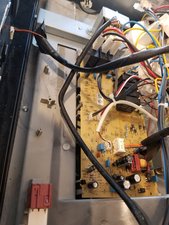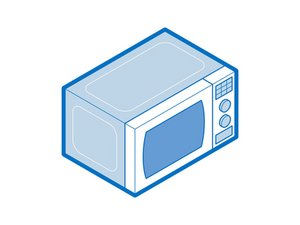Hi @purekoryo ,
What is the make and model number of the microwave oven?
In some ovens there are relays on the control board that are operated to turn on the power to the fans, motor, magnetron etc. once the start button has been pressed
The display saying cooking may just mean that it has registered that it is set up and that the start button has been pressed (along with the door interlocks being OK) and that the cooking should have commenced.
Just a thought.
Hi @purekoryo,
What I meant is that it goes to a board that has the relays on it as it shows that it has relay contacts on it.
Cable from UI connector P2 4&5 goes to connector P26 3&4 on un-named board (is it the inverter board?) and then it doesn't show where or what it does on that board.
Did you check the fuse (shown as fuse - 250mA) on that board (the one where the P26 connector is) to make sure that it is OK?
If it is blown and it is a glass tube type fuse check if you can still see a piece of the fuse wire in there. If so then it may just have fatigued over time and then just failed.
If the fuse wire in the glass tube has completely disappeared then it may have blown and then you'll have to find out why because there is always a reason why a fuse blows.
You could try replacing it with an exact replacement type and value fuse (markings are usually on the fuse end caps showing voltage and amps) and see what happens
The spare plug (does it have red and white wires?) may be for what is shown as the EOL board or component (don't know what this means) which may be needed in another model. I don't know
Hi @purekoryo ,
The fuse connects to P2 pins 2/4/6/8 and P1 pin 4 and not P2 pin 1. the other side of the fuse goes to a component (is it a resistor?) marked as 100E. It could be 3001 but the 1 would be upside down so it makes no sense. You should be able to trace the pcb track from the fuse to the component and the P2 connector pins
The fuse is shown in the picture you posted.
On it I can only read 250V ?50mA so am assuming it is the 250mA fuse.
I did say in my update above, "if" it is a glass fuse, but in this case it is not.
It is the red component - example only behind the connector when looking at the picture.
Search online for "250V 250mA radial pcb mount fuse" to get suppliers that suit you.
crwdns2934105:0crwdne2934105:0
crwdns2934113:0crwdne2934113:0
crwdns2915270:0crwdne2915270:0
crwdns2889612:0crwdne2889612:0
1












 3
3  1
1 
 1.5crwdns2936485:0crwdne2936485:0
1.5crwdns2936485:0crwdne2936485:0 
crwdns2944067:02crwdne2944067:0
Does the turntable spin?
crwdns2934271:0crwdnd2934271:0 Travis crwdne2934271:0
@travisjfox no it doesn't turn. It just says "cooking" and that's it. The timer won't even count down.
crwdns2934271:0crwdnd2934271:0 Jeong crwdne2934271:0